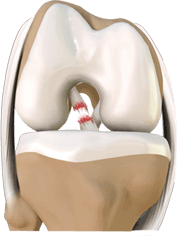ACL TEAR
ACL tear
The anterior cruciate ligament (ACL) is one of the major ligaments of the knee, providing crucial stability and support.
The ACL is located in the middle of the knee, running from the femur (thigh bone) to the tibia (shin bone). Its primary function is to prevent the tibia from sliding out in front of the femur. Along with the posterior cruciate ligament (PCL), the ACL also provides rotational stability to the knee.

- Causes of ACL Injuries
- Symptoms
- Diagnosis
Sports-Related Injuries
ACL injuries are usually sports-related and mostly occur with a severe twisting injury. Common scenarios include:
- Abrupt directional changes with the foot fixed on the ground
- Landing incorrectly from a jump
- Direct contact or collision, such as a football tackle
When you injure your ACL, you might hear a “popping” sound and feel as though the knee has given out. Within the first two hours after injury, your knee will swell and you may experience a buckling sensation during twisting movements.
Diagnosis of an ACL tear involves:
- Reviewing symptoms and medical history
- Performing a physical examination of the knee
- Utilizing diagnostic tests such as X-rays, MRI scans, stress tests of the ligament, and arthroscopy
TREATMENT OPTIONS
Non-Surgical Treatment
Initially, non-surgical methods are recommended:
- Rest, Ice, Compression, and Elevation (RICE protocol): Controls pain and swelling
- Physical Therapy: Improves knee motion and strength
- Knee Brace: Helps immobilize the knee
Surgical Treatment
Indication for surgical treatment requires careful consideration of each patient’s circumstances. Young athletes involved in pivoting sports often require surgery to return safely to their activities. The typical surgery for an ACL tear is ACL reconstruction, which tightens the knee and restores stability. This procedure involves:
- Arthroscopy: Performed through small incisions with an arthroscope. In rare cases, the ACL may be repaired.
- Tissue Graft: Replacing the torn ligament with a graft from the patellar tendon or hamstring muscle
Rehabilitation
Following ACL reconstruction, a comprehensive rehabilitation program is initiated to help resume a wider range of activities. This program focuses on restoring knee strength and flexibility, ensuring a safe return to sports and daily activities. Typically this will continue over a nine month period, with a delayed return to sports once the knee is almost as strong as the other side, and the patient’s balance and agility has returned.













